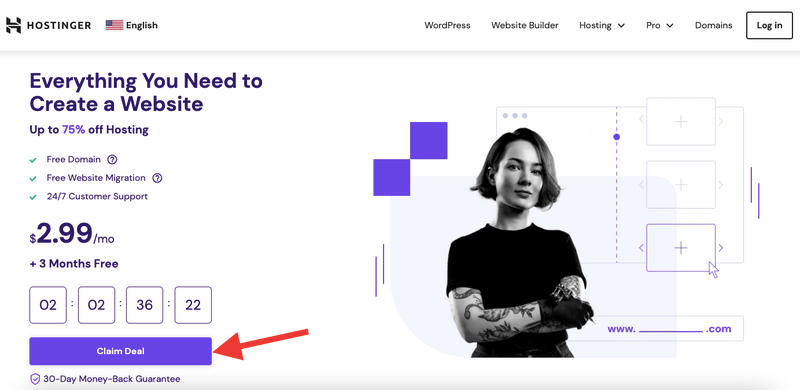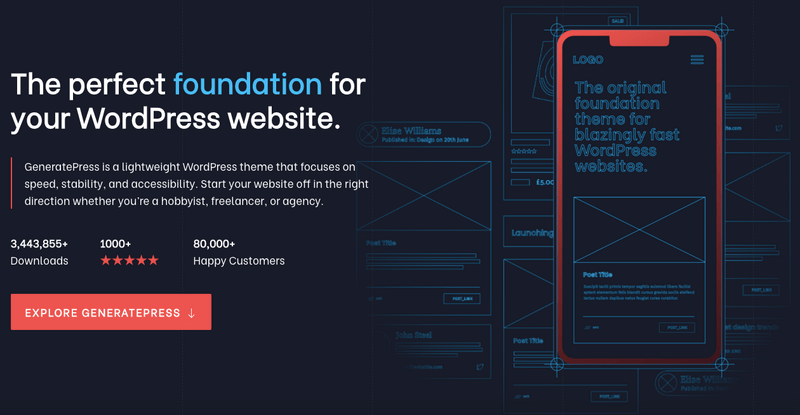Weight loss is a popular and lucrative niche for blogging.
The global weight management industry reached an estimated market value of over $140 billion in 2022 and is projected to grow at nearly 10% from 2023 to 2030.
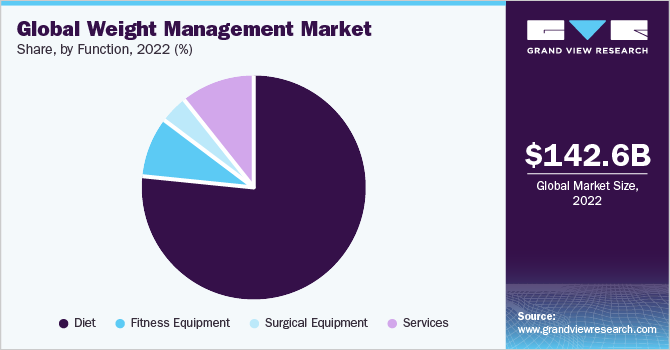
With obesity on the rise worldwide, more and more people are looking for information, advice, and support for losing weight.
A weight loss blog can help you build an audience, establish yourself as an expert, and make money online.
In this comprehensive guide, we will cover everything you need to know about “How to Start a Weight Loss Blog” and grow a successful business online in 2024.
Table of Contents
- What is a Weight Loss Blog?
- Why Start a Weight Loss Blog?
- How to Start Your Weight Loss Blog the Right Way?
- 1. Choosing a Profitable Niche
- 2. Researching Your Target Audience
- 3. Setting Goals for Your Weight Loss Blog
- 4. Choosing a Domain Name
- 5. Choosing Web Hosting
- 6. Installing WordPress
- 7. Choosing a WordPress Theme
- 8. Customizing Your Blog’s Design
- 9. Essential Plugins to Install
- 10. Creating Your Blog’s Navigation Menu
- 11. Optimizing Your Homepage
- 12. Create Great Content
- 13. Promoting Your Weight Loss Blog
- 14. Monetizing Your Weight Loss Blog
- 5 Best Weight Loss Blogs to Get Inspiration
- FAQs
- Final Thoughts on Weight Loss Blogging in 2024
What is a Weight Loss Blog?
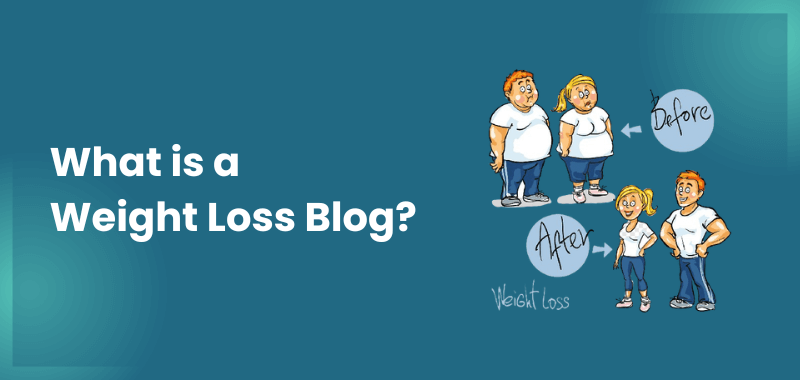
A weight loss blog focuses on providing valuable content centered around weight loss, dieting, fitness, and overall health and wellness. Typical blog posts may include:
- Weight loss tips, strategies, and advice
- Healthy recipes and meal plans
- Workout routines and exercise guides
- Product reviews of diet and fitness-related items
- Success stories and before/after journeys
- Science-based nutrition information
The goal is to position yourself as a knowledgeable expert that readers can trust for credible weight loss information. By providing high-quality content, you can build an engaged audience and become an influential voice in the space.
Why Start a Weight Loss Blog?
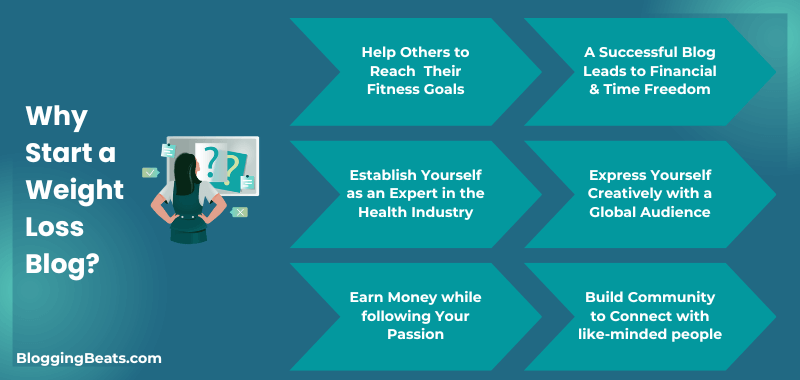
There are many great reasons to start a weight loss focused blog in 2024:
1
Help Others Achieve Their Goals
By sharing your own weight loss journey and expertise, you can motivate and inspire your readers to reach their health goals.
2
Establish Yourself as an Expert
Regularly publishing high-quality content will help demonstrate your knowledge and credibility on weight loss subjects. This can lead to exciting opportunities like book deals, sponsorships, and partnerships.
3
Earn Money from Your Passion
A weight loss blog gives you the platform to monetize your knowledge and content. There is real income potential through avenues like affiliate marketing, advertising, products, and coaching.
4
Achieve Financial & Time Freedom
A successful blog can become a self-sustaining business that provides both financial and time freedom. It takes effort to build, but can eventually run on autopilot.
5
Express Yourself Creatively
Blogging allows you to share your ideas, experiences, and personality with a global audience. It’s immensely fulfilling to produce content you’re proud of.
6
Build Community
Your blog lets you meaningfully connect with readers who share your interests and goals. The relationships built can be incredibly rewarding.
Clearly, weight loss blogging has many advantages if done properly. It provides a way to positively impact lives while creating a profitable business around your passions.
How to Start Your Weight Loss Blog the Right Way?

1. Choosing a Profitable Niche

To maximize your chances of success, it’s important to niche down and focus your weight loss blog on a specific audience and vertical.
Here are some potential niches to consider:
Women’s weight loss
Create content tailored to the unique needs of women trying to lose weight.
You can share pregnancy/post-partum weight loss, menopause, PCOS, and other relevant topics.
Weight loss for seniors
Older adults need a customized approach to weight loss and you can position yourself as an expert in this underserved niche. Discuss challenges seniors face and provide appropriate diet/exercise strategies.
Keto diet
The ketogenic diet remains hugely popular. Focus your blog on low-carb, high-fat keto meal plans, recipes, and lifestyle tips.
Intermittent fasting
Fasting is a proven weight loss method and focusing on it allows you to stand out in the crowded diet space. Provide how-to guides and intermittent fasting plans.
Paleo diet
The Paleo diet has an extremely engaged following. Cater to this audience by sharing Paleo recipes, meal ideas, and tips for following this eating plan.
Fitness for busy moms
Busy moms have trouble finding time to exercise and stay fit. Provide fitness routines for moms on a tight schedule along with kid-friendly healthy recipes.
Weight loss gadgets and tech
Review and recommend the latest weight loss tech like fitness trackers, apps, scales, and more. You can earn commissions through affiliate promotions.
Overall, the key is to drill down into a specific niche you’re truly passionate about. This will set you apart from broader weight loss sites. Become “THE AUTHORITY SITE” for your chosen niche audience.
2. Researching Your Target Audience

Once you’ve settled on a weight loss niche, take time to thoroughly research your target audience. Learn their:
- Demographics – Age, gender, income, location, education level, occupation, etc.
- Interests – What else are they passionate about besides weight loss and your niche? Any hobbies or activities?
- Pain points – What struggles and challenges do they face? What do they need the most help with?
- Objections – What confusions, doubts, or concerns might they have? Address these in your content.
- Preferred content format – Do they like text-based articles, videos, infographics, podcasts, etc.?
- Buying habits – What products and services are they already purchasing? Cater affiliate promotions and your own offers accordingly.
- Where they spend time online – Optimize your content for platforms and communities your audience uses. Participate there.
Truly understand your target reader on a deeper level. This ensures you can create highly tailored content that speaks to their specific needs and interests.
3. Setting Goals for Your Weight Loss Blog

It’s important to set both short and long-term goals for your weight loss blog. Example goals could include:
Short term
- Launch blog within 1 month
- Publish 2 new posts per week
- Reach 500 email subscribers in 3 months
- Generate $200/month in affiliate income within the first 6 months
Long term
- Reach 25,000 monthly readers in 18 months
- Have 100 published posts by the end of the second year
- Earn $5,000/month through affiliate promotions and other monetization
- Get a published book deal with a major publisher
- Launch a successful online weight loss program/membership site
Of course, customize your own blog goals based on your unique vision. Just ensure you have defined objectives to work towards. This will keep you motivated and on track. Re-evaluate your goals regularly.
4. Choosing a Domain Name

Your domain name is one of the first branding decisions you’ll make. The ideal domain should:
- Clearly describe your niche and topic
- Be short, memorable, and easy to spell
- Include your main keyword if possible
- End with a .com extension for the best SEO
For instance, if your niche is intermittent fasting, some potential domains could be:
- IntermittentFastingBlog.com
- IntermittentFastingTips.com
- FastToFit.com
Brainstorm multiple options and see if the .com is available for purchase. Domains usually range from $10-$20 per year.
Tools like LeanDomainSearch, DomainWheel, or Hostinger Domain Checker can assist with domain ideas. Ultimately, choose a domain name with your niche audience in mind.
5. Choosing Web Hosting

Your web host stores all your blog files and data on their servers. They take care of the technical side so your site runs smoothly. And, we recommend Hostinger web hosting.
Hostinger shared hosting is one of the best options for starting WordPress blogs.
Benefits include:
- Fast and reliable performance
- Free domain included
- SSD storage for faster load times
- 24/7 customer support
- Affordable plans starting at $2.99 per month
6. Installing WordPress

Once you have hosting, it’s time to install WordPress, the most popular CMS for blogging.
The good news is Hostinger will do this automatically with one click. Just log into your account and look for the WordPress installation option.
You’ll then be provided dashboard access where you can fully customize your new blog.
Take time to familiarize yourself with the different menu options. This is where you’ll create blog posts, pages, menus, widgets, and more.
WordPress also has a plugins and themes section. We’ll cover how to properly leverage both to maximize your weight loss blog.
7. Choosing a WordPress Theme
Your theme controls the overall design and front-end appearance of your weight loss blog.
Take your time selecting a theme that reflects your brand and provides all the functionality you need.
We recommend a multipurpose theme like GeneratePress or Astra.
Benefits include:
- Professional design options
- Responsive layouts for mobile
- Ability to customize colors, fonts, layout
- Built-in page builder support
- SEO optimization features
- Support and updates
- Library of templates and addons
Both GeneratePress and Astra are lightweight and fast compared to bloated themes. This helps your blog load faster, boosting user experience.
Pricing of GeneratePress
- $59 per year
- $249 one-time fee
Pricing of Astra
- Astra Pro: $47/year
- Essential Bundle: $137/Year
- Growth Bundle: $187/year (including pro features)
Ultimately, choose a theme that’s flexible, fast, and provides the features you need.
Related Posts:
8. Customizing Your Blog’s Design

With WordPress, you can fully customize your blog’s design without needing to code.
Key elements to optimize
- Colors – Choose brand colors that align with your niche. For a weight loss blog cool tones like blues, greens, and purples work well. Use accent colors sparingly.
- Logo – Create a professional logo for your blog brand using a tool like Canva. Keep it simple and relevant to your niche.
- Navigation menu – Set up a clear nav menu that makes it easy for visitors to find important pages like “About” and “Contact”. Group similar pages together.
- Blog post page – Make your main blog page visually compelling and scannable. Use images, whitespace, headings, and emphasis on summary text.
- Sidebar widgets – Widgets like search bars, social icons, and opt-in forms increase engagement. Place them strategically in your sidebar area.
- Theme customizer – Use the built-in customizer to tweak your font selection, layout, paddings, and other design elements.
- Photography – Use premium stock photos relevant to your niche. This improves perceived credibility and brand image.
Take the time to refine your design for maximum appeal and engagement. As you grow, consider hiring a designer to further polish and customize your blog’s look.
9. Essential Plugins to Install
WordPress plugins provide added functionality to your blog. They allow you to easily integrate features without coding.
Here are some essential free plugins to install:
- Rank Math SEO – Optimizes your blog for search engines and helps you target focus keywords.
- WP Rocket – One of the best WordPress caching plugins that improves your website speed and overall performance.
- Smush – Compresses your image sizes without quality loss. Speeds up your page load times.
- Akismet – Helps protect your blog from comment spam. Essential for keeping your site safe.
Start with these core plugins. As your blog grows, you can add others for security, backups, social sharing, contact forms, and more.
Just don’t overdo it, as too many plugins can slow down your site.
Also connect your site to Google Analytics and Google Search Console so you can track traffic and visitor behavior.
Your navigation menu allows visitors to easily access important pages on your weight loss blog. Make sure it includes:
- Home – Your blog home page where you share the newest content.
- About – Page sharing your story, credentials, and why you started your blog. Builds authority and trust.
- Contact – Page with your email address, contact form, and social media links so readers can get in touch.
- Shop – If you plan to sell products or offer services, have a dedicated “Shop” page.
- Start Here / Resources – Useful for first-time visitors. Share your best blog posts and other resources here to get readers started.
- Blog – Page that displays your blog post archives.
- Categories – Page where readers can browse posts by categories like “Recipes” or “Success Stories”.
Organize these clearly in your menu settings. Only link to pages and categories that already exist, otherwise, menu items will lead to dead ends.
11. Optimizing Your Homepage
Your homepage is the first impression visitors get of your weight loss blog. Optimize it to quickly communicate your focus, provide value, and direct visitors to take action.
Effective homepage elements include:
- Headline and subheadline – Communicate your blog’s purpose and niche in a compelling headline. Support this with a subheadline teasing your unique approach.
- Opt-in – Email opt-in forms convert visitors into subscribers who regularly return. Offer a lead magnet like a “Weight Loss Starter Guide” in exchange for their email.
- Blog post teasers – Showcase snippets of your latest blog posts to entice visitors to read more. Include eye-catching imagery.
- About me – Give readers a brief overview of who you are and why you started your blog. Link to a full About page.
- Popular posts – Feature blog post titles and introductions that perform well. Link these to the full versions to increase engagement.
- Navigation menu – Make your key pages accessible right from the homepage for easy navigation.
- Social proof – Display logos of media brands you’ve been featured in. Quotes and testimonials also build credibility.
Refine your homepage over time for maximum impact. Run A/B split tests to see which elements drive the most conversions. Update your homepage regularly to keep it fresh.
12. Create Great Content

Brainstorming Engaging Blog Post Ideas
Consistency is key to growing your audience long term. To maintain frequent posting, you need a reliable system for generating weight loss blog post ideas. Some proven tactics include:
- Leverage your own experiences – Share your personal weight loss journey, including challenges, milestones, and lessons learned. These authentic posts resonate most with readers.
- Curate expert interviews – Interviewing weight loss doctors, personal trainers, nutritionists, etc. provides expert insights readers will love.
- Do product reviews – Reviewing diet books, fitness gear, apps, or other relevant products makes for useful, engaging content. Include pros/cons and affiliate links.
- Cover trending topics – Check Google Trends and news sites to find what weight loss topics are currently popular to cover those
- Share success stories – Profile real people who’ve lost weight using your niche diet or fitness method. This inspires readers and builds authority.
- Answer common questions – Compile frequently asked weight loss questions and provide thorough answers in blog posts. These tend to rank very well.
- Research studies – Find intriguing new weight loss studies and report on the results. Link back to the research.
- Holiday/event tie-ins – Tailor content to holidays, seasons, or cultural events. For example “Healthy 4th of July Recipes”.
- Tools and resources – Share lists of your favorite weight loss tools, apps, sites, and other useful resources for your niche.
Develop your own process to uncover fresh ideas that resonate with your audience. Maintain an editorial calendar to schedule upcoming content.
Conducting Research for Blog Posts
Back each post with thorough research from credible sources. Useful resources include:
- Medical journals – Scan health journals for the latest weight loss studies and breakthroughs to feature.
- Government resources – The CDC, NIH, and USDA have reliable, up-to-date diet and nutrition data to leverage.
- Interviews – Reach out to health experts like doctors, dietitians, and personal trainers to be interviewed as sources.
- Scientific papers – Search databases like PubMed for peer-reviewed papers on weight loss topics that you can cite.
- Industry sites – Check sites like Healthline and Everyday Health for story ideas and statistics.
- Books – Read best-selling weight loss books for quotes, stats, and expert perspectives to cite.
Spend time absorbing information from authoritative sites and people knowledgeable in your niche. Cite these sources in your posts. This lends credibility while providing readers with value.
With research complete, it’s time to start writing your weight loss blog posts. Follow these best practices:
- Keep paragraphs short – Break up long blocks of text with concise paragraphs of just 1-4 sentences. This improves readability.
- Add subheadings – Use H2 and H3 tags for subheads that break up sections and highlight important points
- Insert numbered/bulleted lists – Lists help convey information clearly while making skimming easy.
- Include images – Relevant royalty-free images every 1-2 paragraphs make posts more visually engaging.
- Link to resources – Link to studies, sites, or products mentioned to provide citation sources.
- Share personal experiences – Readers love behind-the-scenes stories and examples from your own weight loss journey.
- Use an informal, conversational tone – Write like you speak to build a connection with your audience. Avoid overly formal language.
- Answer key questions – Anticipate what your readers need to know about your topic and answer those questions in detail.
- End with a call to action – Close each post by encouraging readers to subscribe, comment, share, or click your affiliate links.
Editing and Proofreading Blog Posts
Before hitting publish, properly editing and proofreading your weight loss posts is essential.
Read over each draft. Check that your writing is:
- Easy to understand
- Gets to the point without rambling
- Written concisely using minimal words
Trim any repetitive or unnecessary content. Simplify complex sentences. Ensure all sections logically flow into each other.
Check formatting and SEO
Verify if;
- Heading tags are used properly
- Images are compressed and have alt text
- Links are formatted correctly
- Focus keyphrases are organically incorporated
Proofread for typos and grammar
Carefully proofread each post to catch any:
- Spelling and grammar errors
- Typos or punctuation mistakes
- Broken formatting or coding
Use a tool like Grammarly if needed. A polished, error-free post looks far more professional.
Read out loud
Finally, read your post out loud. This will help you catch awkward phrasing and sentences that need refinement.
Invest time to thoroughly edit and proofread your content before publishing. These quality checks ensure your blog posts are high-value and error-free.
13. Promoting Your Weight Loss Blog
To gain traffic, leads, and authority, you need a promotion strategy that extends beyond your blog. Use these proven tactics:

Search Engine Optimization (SEO)
- Research low-competition/high-traffic keywords and optimize your posts for those
- Include keywords naturally in page titles, subtitles, image names, alt text, etc.
- Create internal links between topical posts
- Get external sites to link back to your content
- Publish long-form in-depth posts 2000+ words long
Social Media Marketing
- Share your weight loss blog posts in Facebook Groups, subreddits, and forums, etc
- Promote your content on your social media channels
- Engage with your niche on Twitter using relevant hashtags and handles
- Run occasional social media ads targeted at your audience
- Collaborate on guest posts with influencers in your space
Email Marketing
- Offer an opt-in incentive like a checklist or ebook in exchange for emails
- Send a weekly or bi-weekly email newsletter with your latest content
- Promote affiliate offers, contests, events, and products to your list
- Share subscriber success stories and testimonials
- Segment your list based on interests to send tailored content
- Research blogs and sites accepting guest posts related to your niche
- Pitch high-quality, custom posts showcasing your expertise
- Aim to secure published guest posts on 1-2 new sites per month
- Link back to your site and specific content from guest posts
Using this promotional mix will ensure your hard work reaches and resonates with your target audience. Eventually, it will convert visitors into loyal followers.
14. Monetizing Your Weight Loss Blog

Wondering how to make money from your weight loss blog?
Well, a profitable blog takes time to build. Focus first on growing your audience and authority. Once established, consider these monetization strategies:
- Promote relevant health/fitness products you use and recommend
- Share affiliate links and coupon codes for brands that align with your niche
- Build relationships with affiliate managers to get better commissions and offers
- Be transparent and let readers know which links are affiliate
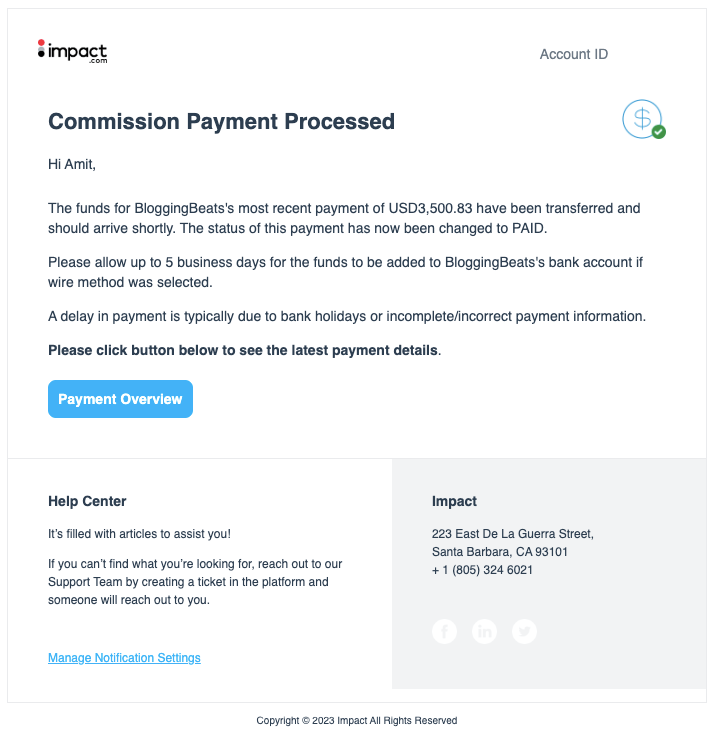
Advertising

- Join an ad network like Google AdSense to display basic ads
- Sell premium ad spots – banners, sponsored posts, etc. directly to brands
- Make sure ads are relevant to your niche and audience
- Monitor program performance and fine-tune your ad placements
Virtual Products
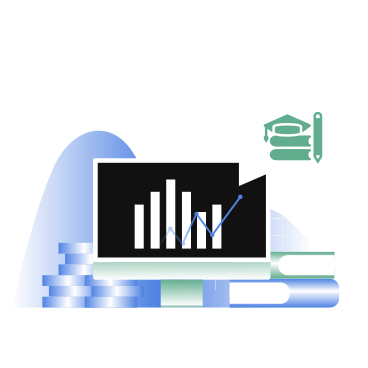
- Sell online products like ebooks, courses, meal plans, and workout guides
- Offer tiered pricing levels like basic, pro, and premium access
- Use payment processors like PayPal or Stripe to handle transactions
- Automate delivery with services like SendOwl
Coaching & Services
- Offer personalized diet/fitness coaching and consulting
- Host private forums or social media groups for paying members
- Consider holding virtual or in-person workshops and events
- Be sure you have the credentials and experience to back up offerings
A diversified income stream is best for long-term stability. Always deliver real value in exchange for revenue. Stay focused on serving your audience.
5 Best Weight Loss Blogs to Get Inspiration
Below are the 5 ultimate weight loss blogs run by health experts you may follow for ongoing inspiration and guidance.
1. Fitnessista
This blog is run by Gina where she writes about effective workouts and healthy recipes.
2. Lasta.app
This is an all-in-one intermittent fasting app, also having a dedicated blog section where you will find content related to Intermittent fasting, Male health, Female health, Body, Challenges, Diets, Meal plans, Meditation, Mental health, Nutrition, Workouts, etc.
3. Snack Girl
This blog is owned by Lisa Cain where you will find healthy & easy recipes, supportive weight loss advice, packaged food buying tips, and more.
4. Run Eat Repeat
Monica is the owner of this blog where she shares running tips, recipes, and training plans.
5. Organize Yourself Skinny
It’s a go-to resource for healthy recipes, cooking tips, and lifestyle hacks.
FAQs
Here are a few frequently asked questions related to weight loss blogging;
Yes, weight loss blogs can earn money through advertising, affiliate marketing, digital products, coaching services, and more. But quality content and audience should come first.
Choose a specific diet niche, get hosting and install WordPress, customize your design, create SEO-optimized content, and promote on social media. Focus on value for readers.
Share personal experiences, healthy recipes, product reviews, expert interviews, success stories, research studies, dieting tips, and fitness advice.
Document your journey, weigh-ins, meal plans, and feelings in a printed or online journal. Share insights, progress photos, and reflections.
Yes, you can start a fitness blog on any niche like yoga, running, strength training, etc. Provide useful training plans, safety tips, product reviews, and healthy recipes.
Also Read:
- Pet Blogging: How to Start a Pet Blog & Make Money in 2024
- Event Blogging: Unlocking the Potential to Make Money Online in 2024
- How to Start a Fashion Blog and Make Money Online in 2024
- Product Review Blogger: Launching a Successful Product Review Blog in 2024
- How to Start a Micro Niche Blog and Maximize Profits in 2024
- How to Start a Travel Blog and Make Money From It in 2024
- How to Start a Food Blog and Make Money Online in 2024
- How to Start a Soccer Blog and Make it Profitable in 2024
- Top 16 Blogging Mistakes To Avoid in 2024 (For Amateur Bloggers)
- The Future of Blogging in 2024: Trends and Predictions
Final Thoughts on Weight Loss Blogging in 2024
Starting a successful weight loss blog takes dedication, consistency, and a strategic approach. But it can be an extremely rewarding endeavor – both personally and financially.
By leveraging your knowledge to help others achieve their health goals, you can build an audience of loyal followers and establish yourself as an authority in your niche.
With hard work and persistence, blogging has the potential to replace your 9-5 while allowing you to work on your own terms.
Just stay focused on providing value to your readers above all else. Build relationships and trust with your audience. And continue educating yourself so you can offer the best diet and fitness advice possible.
If you stay committed to serving people with high-quality content, your weight loss blog can pave the path to the freedom, fulfillment, and income you desire.
If you have any questions related to “How to Start a Weight Loss Blog”, feel free to comment below.
